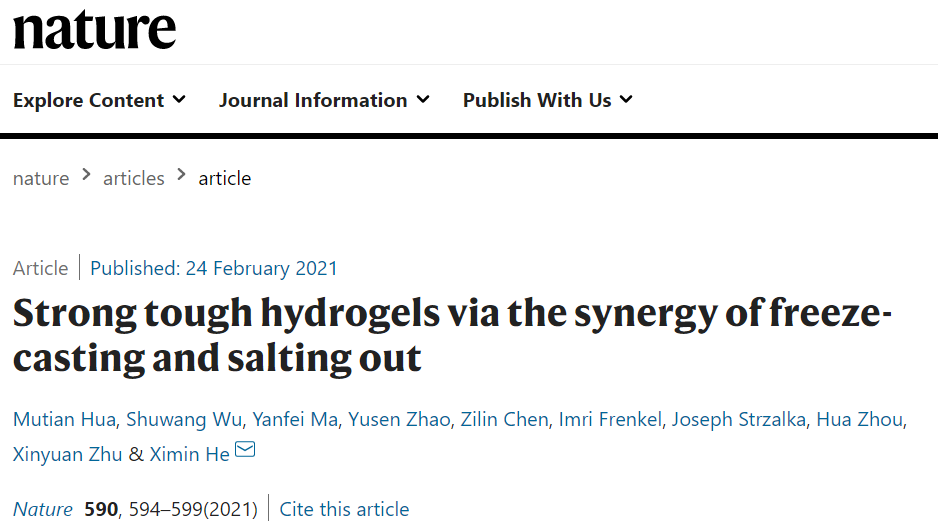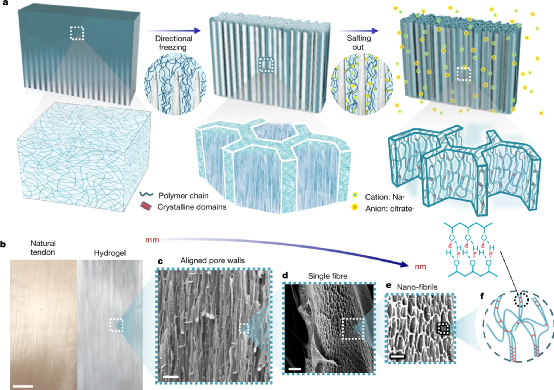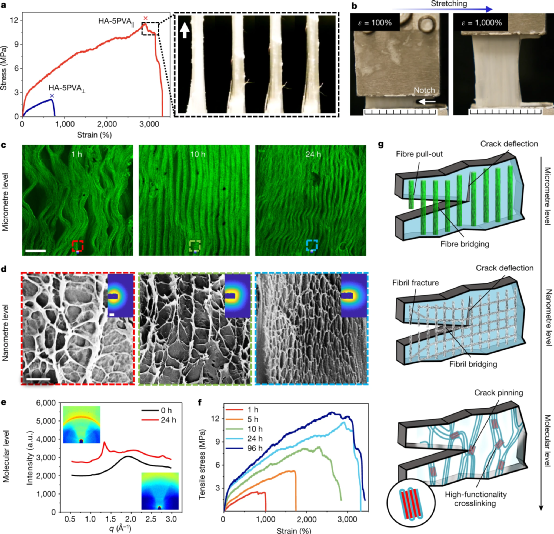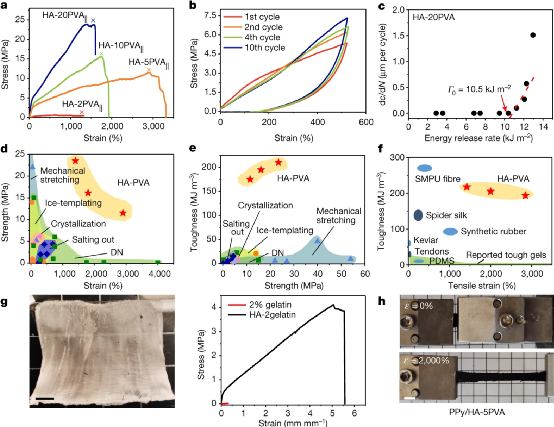Nature blockbuster | Hydrogel biomaterials get a new breakthrough!
Natural load-bearing materials (for example, tendons) have a high water content of about 70%, but they are still tough even if they are used more than 1 million cycles per year due to the layering of anisotropic structures in multiple length ranges Due to the combination.
Hydrogels are a wide range of materials whose internal structure is composed of cross-linked polymers or gels. They are expected to be used as replacement tissues, can be used to temporarily close wounds, or as long-term or even permanent solutions. In addition, the gel can be used in soft robots and wearable electronic devices.
At present, synthetic hydrogels have been prepared by methods such as electrospinning, extrusion, compounding, freezing casting, self-assembly, and mechanical stretching to improve their mechanical properties. However, compared with tendons, many hydrogels with the same high water content do not exhibit high strength, toughness, or fatigue resistance. In addition, the aggregation state of the polymer can be changed by simply adding specific ions. This is called the Hofmeister effect, in which different ions have different abilities to precipitate polymers.
In view of this, Professor He Ximin of the University of California, Los Angeles and others have adopted a combination of molecular and structural engineering methods that have not been used before, that is, the strategy of using freezing-assisted salting-out treatment to produce multi-length-scale layered hydrogel structures. Prepare the hydrogel. The synthetic biomaterials prepared by this new method can mimic the internal structure, stretchability, strength and durability of tendons and other biological tissues.
In addition, these hydrogels can be used to prepare artificial tendons, ligaments and cartilage that are 10 times stronger than natural tissues. Although hydrogels mainly contain water with a small amount of polymer (about 10% polymer), they are more durable than 100% polymer Kevlar and rubber. Prior to this, such a breakthrough had never been achieved in water-containing polymers. The new hydrogels can also provide coatings for implantable or wearable medical devices to improve their fit, comfort, and long-term performance. This work demonstrates a promising approach for man-made biomaterials that are comparable or even stronger than natural biological tissues. The results were published in the journal Nature.

Two-pronged approach The researchers used a two-pronged approach to enhance the strength of existing hydrogels, and used polyvinyl alcohol (a material that has been approved by the US FDA) to make a prototype of the hydrogel.
1) First, the researchers used a method called "freeze casting". This solidification process produces a porous and concentrated polymer that resembles a sponge. 2) Second, they used the "salting out" treatment to aggregate and crystallize polymer chains into strong fibrils. The resulting new hydrogel has a series of connected structures spanning multiple different scales (from the molecular level to a few millimeters). The hierarchical structure of these multiple structures is similar to the biological counterpart, making the material stronger and more stretchable.

Figure | Preparation and hierarchical structure of HA-PVA hydrogel
The polyvinyl alcohol hydrogel produced with excellent performance is highly anisotropic, including micron-sized honeycomb pore walls, which in turn contain interconnected nanofiber networks. They tested its durability and found no signs of degradation after 30,000 tensile tests. Under light, the new hydrogel produced a realistic shimmer, similar to a real tendon, confirming the micro/nano structure formed in the gel.

Figure | Mechanical properties and structure evolution of HA-PVA hydrogel
The water content of these hydrogels is 70%-95%, but their performance is better than other tough hydrogels and even natural tendons; for example, the ultimate stress is 23.5±2.7 MPa, the strain level is 2900±450%, and the toughness is 210± 13 MJ/m3, fracture energy is 170±8 kJ/m3, fatigue limit is 10.5±1.3 kJ/m2. In addition to biomedical applications, due to the flexibility of hydrogels, this advancement may also bring potential to surgical machines or bioelectronics that operate countless cycles, as well as 3D printing that was previously unattainable.

Figure | Adjustable mechanical properties and versatility
Summary In summary, the researchers used freezing-assisted salting-out treatment to develop hierarchical hydrogels with high strength, toughness, stretchability and fatigue resistance. Considering that the Hofmeister effect exists in various polymer and solvent systems, the proposed strategy is not limited to the system proposed in this paper. It is foreseeable that with this strategy, the originally weak hydrogel can be used in fields such as medical care, robotics, energy, and additive manufacturing.
References: Hua, M., Wu, S., Ma, Y. et al. Strong tough hydrogels via the synergy of freeze-casting and salting out. Nature 590, 594–599 (2021).https://doi. org/10.1038/s41586-021-03212-z
Hydrogels are a wide range of materials whose internal structure is composed of cross-linked polymers or gels. They are expected to be used as replacement tissues, can be used to temporarily close wounds, or as long-term or even permanent solutions. In addition, the gel can be used in soft robots and wearable electronic devices.
At present, synthetic hydrogels have been prepared by methods such as electrospinning, extrusion, compounding, freezing casting, self-assembly, and mechanical stretching to improve their mechanical properties. However, compared with tendons, many hydrogels with the same high water content do not exhibit high strength, toughness, or fatigue resistance. In addition, the aggregation state of the polymer can be changed by simply adding specific ions. This is called the Hofmeister effect, in which different ions have different abilities to precipitate polymers.
In view of this, Professor He Ximin of the University of California, Los Angeles and others have adopted a combination of molecular and structural engineering methods that have not been used before, that is, the strategy of using freezing-assisted salting-out treatment to produce multi-length-scale layered hydrogel structures. Prepare the hydrogel. The synthetic biomaterials prepared by this new method can mimic the internal structure, stretchability, strength and durability of tendons and other biological tissues.
In addition, these hydrogels can be used to prepare artificial tendons, ligaments and cartilage that are 10 times stronger than natural tissues. Although hydrogels mainly contain water with a small amount of polymer (about 10% polymer), they are more durable than 100% polymer Kevlar and rubber. Prior to this, such a breakthrough had never been achieved in water-containing polymers. The new hydrogels can also provide coatings for implantable or wearable medical devices to improve their fit, comfort, and long-term performance. This work demonstrates a promising approach for man-made biomaterials that are comparable or even stronger than natural biological tissues. The results were published in the journal Nature.

Two-pronged approach The researchers used a two-pronged approach to enhance the strength of existing hydrogels, and used polyvinyl alcohol (a material that has been approved by the US FDA) to make a prototype of the hydrogel.
1) First, the researchers used a method called "freeze casting". This solidification process produces a porous and concentrated polymer that resembles a sponge. 2) Second, they used the "salting out" treatment to aggregate and crystallize polymer chains into strong fibrils. The resulting new hydrogel has a series of connected structures spanning multiple different scales (from the molecular level to a few millimeters). The hierarchical structure of these multiple structures is similar to the biological counterpart, making the material stronger and more stretchable.

Figure | Preparation and hierarchical structure of HA-PVA hydrogel
The polyvinyl alcohol hydrogel produced with excellent performance is highly anisotropic, including micron-sized honeycomb pore walls, which in turn contain interconnected nanofiber networks. They tested its durability and found no signs of degradation after 30,000 tensile tests. Under light, the new hydrogel produced a realistic shimmer, similar to a real tendon, confirming the micro/nano structure formed in the gel.

Figure | Mechanical properties and structure evolution of HA-PVA hydrogel
The water content of these hydrogels is 70%-95%, but their performance is better than other tough hydrogels and even natural tendons; for example, the ultimate stress is 23.5±2.7 MPa, the strain level is 2900±450%, and the toughness is 210± 13 MJ/m3, fracture energy is 170±8 kJ/m3, fatigue limit is 10.5±1.3 kJ/m2. In addition to biomedical applications, due to the flexibility of hydrogels, this advancement may also bring potential to surgical machines or bioelectronics that operate countless cycles, as well as 3D printing that was previously unattainable.

Figure | Adjustable mechanical properties and versatility
Summary In summary, the researchers used freezing-assisted salting-out treatment to develop hierarchical hydrogels with high strength, toughness, stretchability and fatigue resistance. Considering that the Hofmeister effect exists in various polymer and solvent systems, the proposed strategy is not limited to the system proposed in this paper. It is foreseeable that with this strategy, the originally weak hydrogel can be used in fields such as medical care, robotics, energy, and additive manufacturing.
References: Hua, M., Wu, S., Ma, Y. et al. Strong tough hydrogels via the synergy of freeze-casting and salting out. Nature 590, 594–599 (2021).https://doi. org/10.1038/s41586-021-03212-z
18915694570
Previous: Jilin University/South


